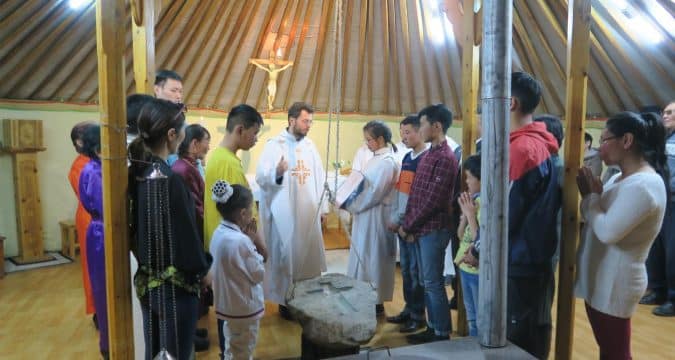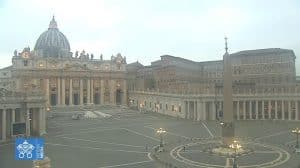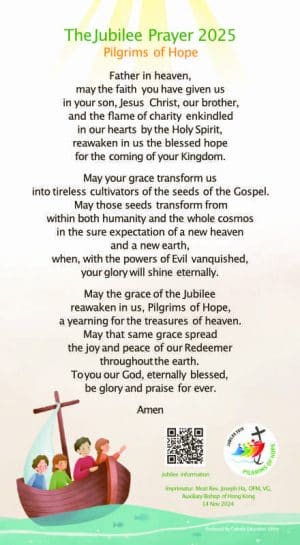
VATICAN (CNS): Pope Francis continually calls Catholics to go to the “peripheries,” and that is exactly what he will do on August 31 when he boards a plane to Mongolia.
Bordering both Russia and China, Mongolia is one of the few countries Pope St. John Paul II did not manage to visit, although plans were well underway for such a visit in 2003 when the well-travelled Polish pope also had hoped to make a brief “technical stop” in Kazan, Russia, to return to the Russia Orthodox Church the famed icon of Our Lady of Kazan.
St. John Paul’s failing health, the Russian Orthodox patriarch’s lack of enthusiasm, and the logistical challenges of a very small Catholic community hosting a papal visit all contributed to the plan being scratched.
Pope Francis, who is scheduled to be in Mongolia from September 1 to 4, will visit a Catholic community that has grown from fewer than 200 members in 2003 to some 1,450 today.
When John Paul II missed the trip, he sent a cardinal to ordain the first bishop for the Apostolic Prefecture of Ulaanbaatar, the jurisdiction—smaller than a diocese—that continues to cover the entire nation. Mongolia now has its own cardinal, the 49-year-old Giorgio Cardinal Marengo, who has been a missionary in Mongolia for more than 20 years.
While in Rome in mid-July for a conference on catechesis, Cardinal Marengo said “whisper” was the best verb to describe missionary activity in Mongolia.
One does not whisper to the first person [he meets] on the street; otherwise, you will be taken for a fool. You whisper to a friend, to a person you love
Cardinal Marengo
Whispering is a “means of profound and respectful communication, which can occur only in the context of a relationship of friendship,” he said. “One does not whisper to the first person [he meets] on the street; otherwise, you will be taken for a fool. You whisper to a friend, to a person you love.”
Mongolia, with 3.3 million inhabitants, is a sparsely populated country of vast distances where Soviet-influenced communist rule lasted close to 70 years and included the harsh suppression of religion, including the killing of Buddhist monks.
According to the US State Department, in the country’s national census in 2020, more than 40 per cent of Mongolians said they had no religious identity. Of the 60 per cent who said they were religious, some 87 per cent said they were Buddhist, just over five per cent were Muslim, four per cent followed traditional Mongolian religion, usually referred to as “shamanism,” and just over two per cent were Christians.
According to Fides, the small Catholic community counts two Mongolia-born priests. It has nine churches and chapels—including a ger [sometimes referred to as a yurt] and a cathedral of brick and mortar modeled after the traditional Mongolian dwelling. The people are served by 30 women religious and 25 missionary priests from a variety of countries.
Close to 28 per cent of the population lives below the national poverty line, according to the Asian Development Bank.
Cardinal Marengo told Fides in August that about 70 per cent of the Catholic Church’s time and resources in Mongolia are devoted to charity and social activities, including running day-care centres, a trade school, homes for orphaned or homeless children and soup kitchens
Cardinal Marengo told Fides in August that about 70 per cent of the Catholic Church’s time and resources in Mongolia are devoted to charity and social activities, including running day-care centres, a trade school, homes for orphaned or homeless children and soup kitchens.
Pope Francis’ last appointment in Mongolia is scheduled to be a meeting September 4 with charity workers and the inauguration of the House of Mercy, which will house a shelter for women and children escaping domestic abuse and offer temporary housing to migrants forced to return to Mongolia.
The UN International Organisation for Migration country report for Mongolia estimates one in 11 Mongolians are living outside the country, and those who leave tend to be young, educated and skilled.
But the organisation also drew attention to “internal migration,” people leaving their traditionally nomadic lives as herders and moving into the city. The population of Ulaanbaatar, now estimated at 1.6 million people—half the country’s population—is more than double what it was in 2000. The urban influx has been pushed by a search for economic opportunities, particularly in light of fast-growing desertification from climate change and overgrazing and environmental degradation caused by mining for coal, copper, gold and other minerals.
The situation is a perfect setting for Pope Francis to talk about the importance of “integral ecology” as proposed by Catholic social teaching, recognising how the preservation of the natural environment also means preserving Mongolian culture, the dignity of its people and their livelihoods.
In showing respect for his hosts and encouraging the small Mongolian Catholic flock, Pope Francis will need to honour traditional Mongolian culture, just as Cardinal Marengo and the other missionaries have tried to do.
“Sometimes Christianity in Mongolia is considered something recent, new and imported,” the cardinal told Fides, but “the Christian faith has very ancient roots” in the region, going back to the 7th century, and “we also know that in the era of the great empire of Genghis Khan [who died in 1227], some commanders, soldiers were of the Christian faith.”
In the 1920s, the Vatican formally established mission structures in Mongolia, but within a year of the country becoming communist, it ceased to function. It wasn’t until 1991 that Catholic missionaries returned and began rebuilding the community.
Pope Francis is scheduled to hold an ecumenical and interreligious meeting on the morning of September 3 before celebrating Mass with the country’s Catholic community.
While a variety of other Christian missionaries are expected to attend, the Buddhist delegation is expected to be the most significant.








